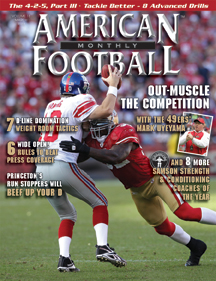Article CategoriesAFM Magazine
|
Your Take – Get the Head Out of Footballby: Tony DeMatteoHead Coach, Somers High School (NY) © More from this issue At every level of football, greater awareness of the dangers of head injuries and the role that helmet-to-helmet contact often plays in them has led to rule modifications and, in many cases, a greater effort by coaches to minimize the risk of head injuries by incorporating blocking and tackling techniques that take the helmet out of the game. It is critical that this continue to help ensure safety of players and protect the future of the game. Since being taught the proper blocking and tackling techniques starts at the youth level, it is particularly important for youth coaches to understand how to teach young players the safest, best way to play the game. Youth coaches also need to actively involve parents in their program in order to make them aware of safety measures that are being taken to protect their children. Blocking and tackling must be made with the players’ shoulder pads and never the helmet. Striking with the shoulder to execute a block is the safest way to contact an opponent. Shoulder blocking prevents leading with the head or striking with the eyebrows or hands; techniques that can cause serious injury when poorly executed. As a high school coach with 42 years experience, I realize that many, if not most coaches, teach their players to block and tackle with their heads in the middle of the opponent rather than off to the side because they feel it is more effective. While every coach would agree that it’s critical to coach players to keep their heads up when blocking and tackling, I believe that it’s also important to teach them to keep their head to the side as this is a much safer technique and player safety should be the highest priority for all coaches. Tackling can be the most dangerous aspect of playing football. Risks can be minimized, however, if it is taught properly. Players should be instructed to put their face on the ball, or “bite the ball” since the ball carrier will be holding the ball on one side or the other. Teaching tackling this way gets players to keep their heads up and off to the side so they are making contact with the shoulder. When running one-on-one tackling drills, players should be gradually separated and start at half speed before advancing to full speed drills. Players should never be brought to the ground in any tackling drill. That should only occur during games. Parents also want to be reassured that emergency procedures are in place during practices and games should an injury occur. They have every right to ask these questions. I believe that preseason parent-coach meetings are important opportunities for coaches to answer parents’ questions and concerns. The concerns of many parents in the past centered on playing time for their sons, and that can still be the case today. But, with the attention shifting to player safety, coaches need to be prepared to answer questions about how they teach to take the head out of blocking and tackling, how they conduct practices and how they ensure that every child is put in a situation where they have an opportunity to succeed. Most importantly, coaches need to be aware of medical procedures that need to be followed if an injury occurs or is suspected and communicate these to parents. If no adequate protocol for an injury situation exists in the program, it is the coach’s responsibility to work with medical professionals and local/school officials to make sure one is instituted before the first player steps onto the practice or game field. In order to protect the future of football, coaches must take an active role in teaching blocking and tackling techniques that take the head out of the game. They also need to be their programs’ ambassador to the parental community to provide critical safety information that will reassure parents that their sons are participating in the safest possible football environment. |
|
| HOME |
MAGAZINE |
SUBSCRIBE | ONLINE COLUMNISTS | COACHING VIDEOS |
Copyright 2026, AmericanFootballMonthly.com
All Rights Reserved




